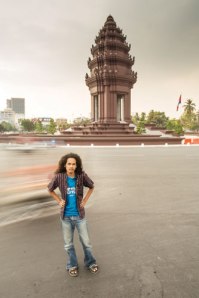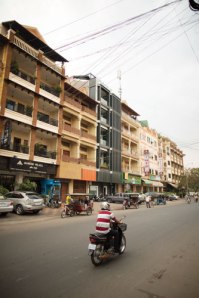
Artist Reaksmey Yean has been vocal in his criticism of the artist selection process for Seasons of Cambodia. Photograph: Alexander Crook/Phnom Penh Post
A FEW years ago, Leang Seckon, artist and graduate of Royal University of Fine Arts,painted by the shores of Boeung Kak lake in a ramshackle, wooden studio. For the month of April, his studio will be the Bronx, New York City.
The mixed-media artist has garnered critical acclaim over the past decade for his kaleidoscopic collages, which have shown in London, Singapore, Myanmar, China and more.
This year’s residency at the Bronx Museum comes as part of the highly anticipated Seasons of Cambodia (SOC) festival in its visual arts program – perhaps the biggest ever international celebration of Cambodian arts.
Throughout April and May, over 125 Cambodian artists – traditional Khmer and contemporary dancers, film-makers, performance artists, musicians, sculptors and photographers – will fly to New York City for the festival.
On February 23, Phnom Penh-based artist Sopheap Pich’s intricate scultptures were unveiled in a solo exhibition, Cambodian Rattan: The Sculptures of Sopheap Pich, at the esteemed Fifth Avenue space the Metropolitan Museum of Art – part of the museum’s contribution to SOC – running until mid-June.
The artist will also have exhibitions at Tyler Rollins Fine Art and the World Financial Centre’s Winter Garden, while 32-year-old Cambodian Vandy Rattana’s affecting, and applauded, series of photographs and video, Bomb Ponds, which explored the country’s violent past through its landscape, opened in an exhibition at New York’s Asia Society Museum just over a week ago.
A “historical inquiry” symposium – a one day academic forum with renowned scholars, curators, and artists exploring Cambodian contemporary art, along with other residencies and open studio days with emerging Khmer artists shape the rest of the visual arts program.
The residencies, all running for two months, except for Seckon’s, are the highlight of the visual-arts program for co-curator Erin Gleeson, artistic director of Phnom Penh’s white, minimalist art space Sa Sa Bassac and New York- based program director Leeza Ahmady, a commended independent art curator, part of the dOCUMENTA team in Germany and a specialist in the art of Central Asia.
Gleeson, who has curated more than 40 exhibitions with Cambodian artists over her 10 years in the country, said it was critical to have a “process-based” festival.
“A lot of people are asking, why aren’t we having a big exhibition … but I think if that were to happen work is put up against other work and the equation is reviewed as a curatorial equation.
“We were very much shaped and inspired by our partners in New York. The very few site-specific installations were the artists they wanted to work with … So the basis is very much the residencies.”
However, many in the local arts community have, over the festivals three-year development, criticised the visual-arts program and the curatorial process, suggesting the selection process was biased and poorly communicated to artists outside of the capital. There was too much emphasis on photography, they have argued.
On Saturday, dozens of artists, SOC, Cambodia Living Arts (CLA) − the lead partner and sponsor of the festival − staff and curators gathered at a “community meeting” arranged by CLA to alleviate simmering tensions.
Reaksmey Yean, a prominent performance artist, argued that eight of the 12 artists selected are affiliated with Sa Sa Bassac and painters, particularly young artists from the arts hub of Battambang, were excluded.
A group of 30 artists had signed a letter in protest of the selection process, according to Yean.
“At the meeting we were shown a chart of the selection process … Nowhere on that was a list of names she may have put forward. There were no other names than the ones selected in residence. We want to know who she put forward. I’m not angry at all, I just want things to be fair,” he said.
“I don’t want to destroy the program of SOC, I respect it very much. It is so important to make Cambodia visible…but for me I don’t think an artist has to be educated in Europe or America … The point is, a curator attached to a gallery cannot be unbiased.”
Battambang painter Robit Pen said he had only found out about SOC after a press release was issued notifying of the final selection.
“I don’t think I have enough credentials to go yet, but communication should have been much better. You can’t call it visual arts either when there are no painters.”
His fellow Battambang painter Chov Theanly, agrees. “We didn’t really know anything about the selection. Nobody visted my studio. It’s OK, the guys going are great. They do represent Cambodia. I don’t want to make them feel bad. I’d like to say good luck to them,” he said.
Cambodian-born, American-raised artist Anida Yoeu Ali, a curator in the festival’s diaspora panel, said the visual arts selection should have been broader.
“It’s a little bit limiting because it’s a very specific group that does not show diversity and range of educational background, the true nuances of the contemporary art scene,” she said.
Gallery curators have also expressed concern. Kate O’Hara, curator at Romeet Gallery, said: “The artists selected are all very interesting and engaging. However, whether the curatorial proposal is representative of contemporary Cambodia art now, whether previously seen or unseen in the international landscape before, is what I question.”
Dana Langlois, Director at Jafe Café and Gallery, was involved in the initial planning stages of the festival but left because she was “concerned also about the issue of conflict of interest” and “not comfortable with some of the processes”.
“What upsets me is the process itself, the lack of transparency and communication… New York City is far away and inaccessible to most, making many in the arts community feel powerless and frustrated in this process.”
Gleeson stands by her and Ahmady’s selections and the curatorial process. She said “delegations” of these institutions had travelled around Cambodia throughout the process.
“I do not work with painters … The truth is … photography is one of the strongest practices here.”
She said with a small, developing arts community came overlaping roles, and that it would be hard for someone not attached to a Cambodian gallery or space to curate.
Phloeun Prim, CEO of SOC, and executive director of CLA said: “There was a need to connect with the community, there were a lot of questions unanswered. Clearly a learning process for us, more about communication, engaging, how we can be more inclusive in the process … This is the first time, especially with the visual arts program, we have learnt about this.”
Original article by Phnom Penh Post and written by Claire Knox


Oh, I understand the feeling so well… of course, Cambodia should be well-represented by a broad spectrum of artistes. But perhaps, gallery curators are human, with their biases. I’m sure you have already thought of this…. put it in a blog… online viewers can drive a lot of opinion and clout. 🙂 I would be happy to help in any way I could…. good luck!
Yes, I hope many more people will read this and give me more comments so that more dialog will begin and I can learn new ideas… thank you though for your words.
Insha-allah, you will be successful!
This seems very complicated, but if I understand correctly, photos are preferred over paintings, etc. Although I love beautiful photography, that seems odd to me.
It is also about that and also about the representation of Cambodian arts…
In general, the world in not fair. And the business world has never been “fair” to artists or workers. That’s why unions were created and why artists should use their voices to expose gross unfairness. It’s good to hear your voice and others as you work to make the art world a little more open, a little more fair.
I am confused, though. The article says you are a performance artist, but I see all of these glorious paintings on your blog. Are you both a painter and performance artist? If you were to have a show in San Francisco, there are many people who would love your work!
I totally agree with you that nothing is actually “fair” when it comes to commercialization or business like. However, artists should break that rule and be a ruler and a leader of themselves. Be independent!!!!
Thank you for your comment. I am a performance art practitioner. I can’t call myself an artist yet, ’cause as you may read, I don’t have enough credentials to be called as such according to the curators’ criterion and definition of artist.
I am an awful painter, though, I was trained in painting for one year. My most trainings are in traditional music and theater. I am an art advocate and publicist, and the artworks you see in my blog belongs to artist I’ve been working with. Hope to be in San Francisco one day.